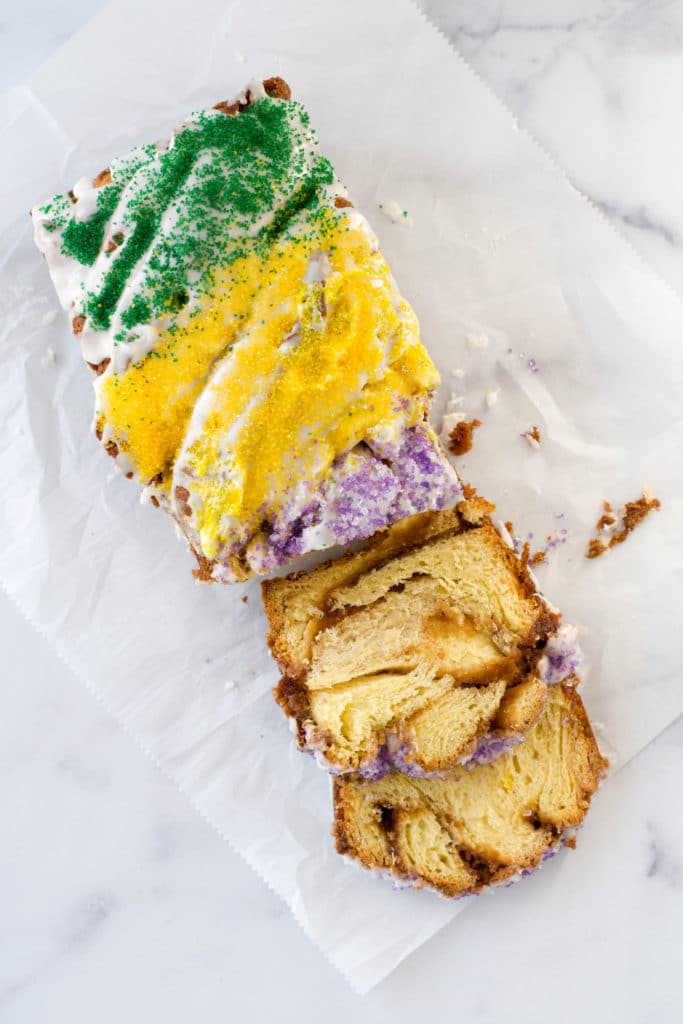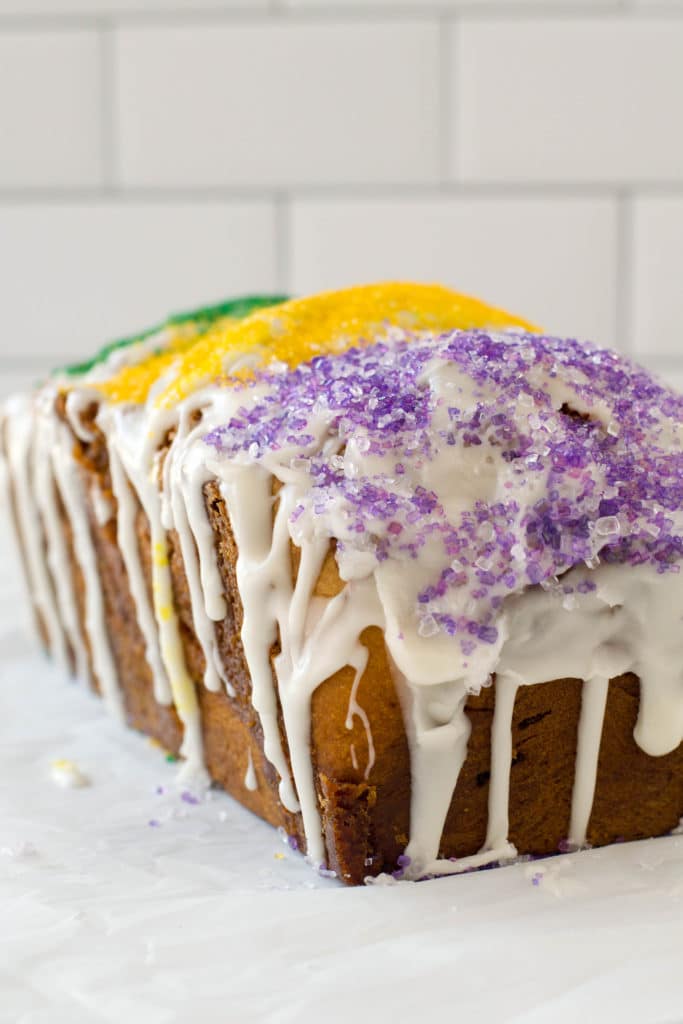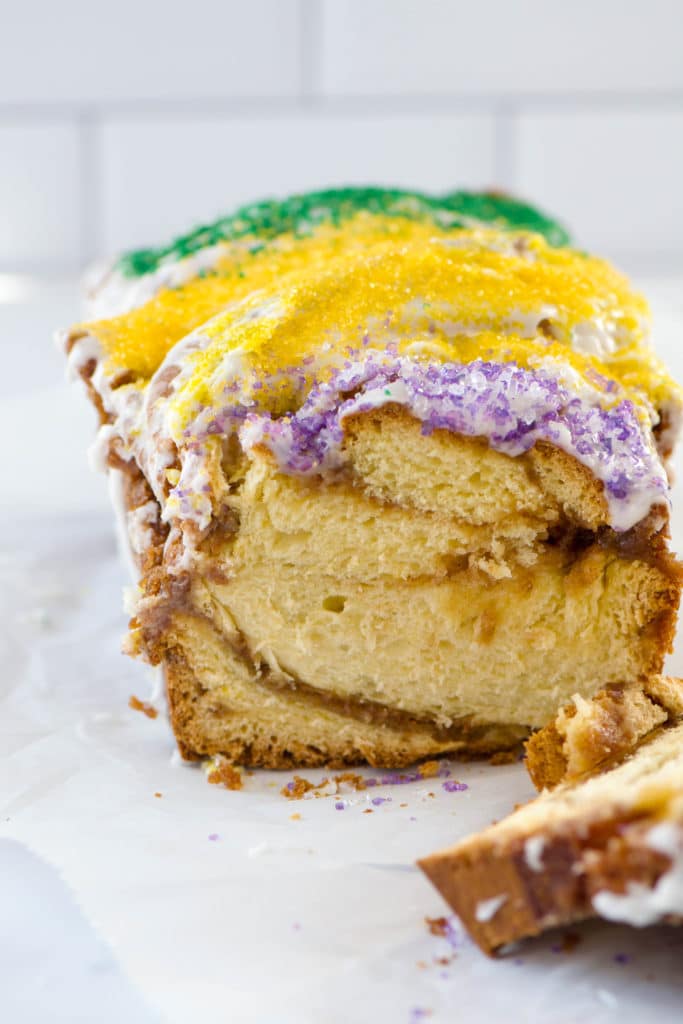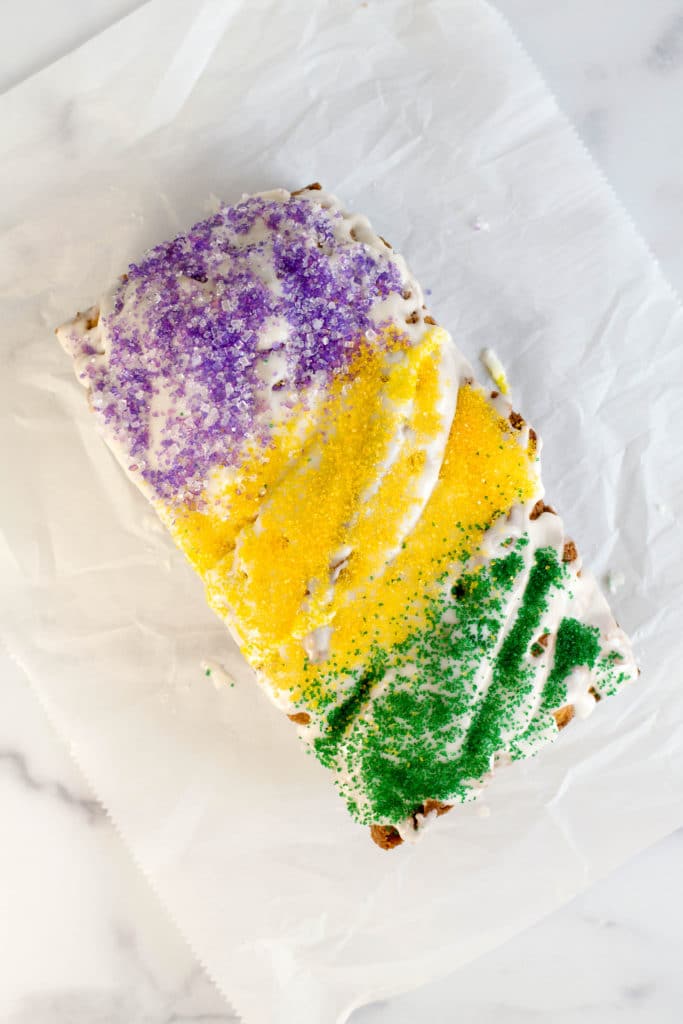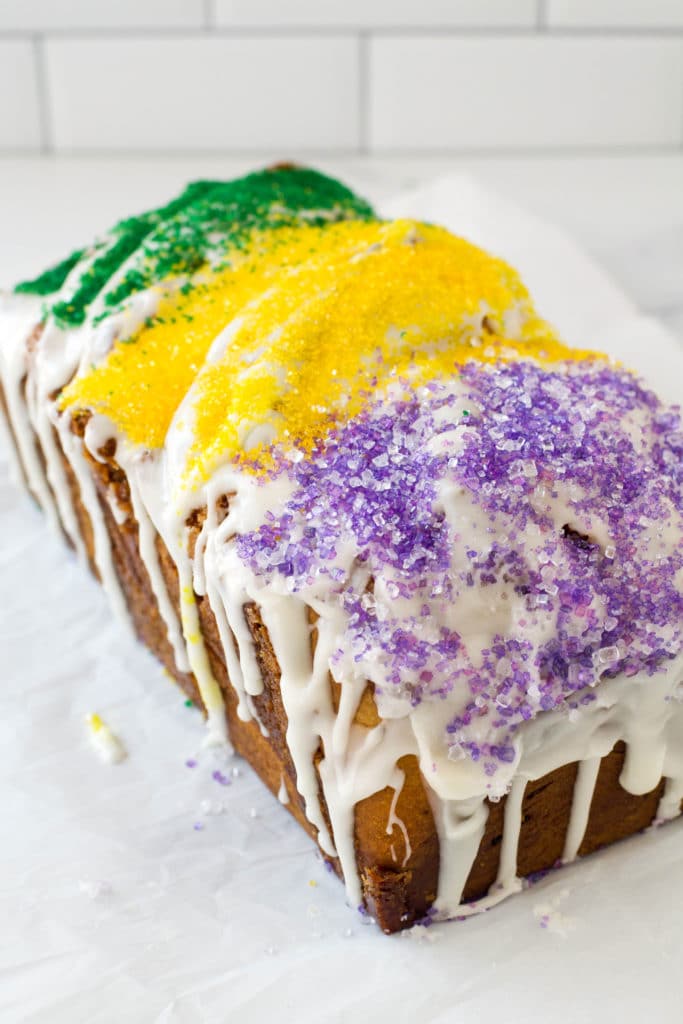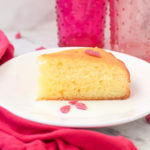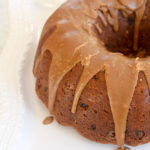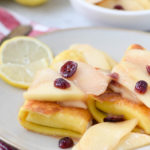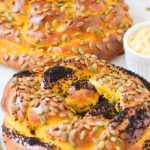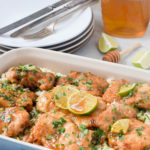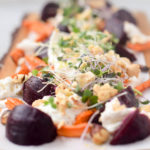Imagine a cinnamon babka topped with sweet icing and decorated with sprinkles in classic Mardi Gras colors of green, gold and purple. It’s a King Cake Babka!
Are you a fan of King Cake? My daughter has a friend whose mother is from New Orleans and every February when the girls were in elementary school, this mother would bring in an authentic New Orleans-style King Cake and tell the kids about Mardi Gras – the PG version, of course. My daughter remembers those visits fondly, mostly because of the novelty of eating a sweet, sugary cake covered in sprinkles during the school day.
King Cake is one of the most famous New Orleans culinary traditions. I have never actually been to the Big Easy, which I regret. But I have long enjoyed New Orleans cuisine. Remember the 80’s when Cajun and Creole food was trendy for a hot second? I certainly do. I had an uncle who, depsite having been born in Germany, built his culinary career on making Cajun food and, for a long time, he owned a beloved restaurant in Bethesda, Maryland called Louisiana Express. Man, I still miss those beignets.
In New Orleans, one starts seeing King Cakes around January 6, which is the Feast of the Epiphany. The eponymous King, or Kings, are, in fact, the Three Wise Men in the Christmas story. In Europe, a King Cake, such as France’s galette de rois, looks rather different and is really only served on the Feast of the Epiphany. In New Orelans, however, the King Cake season continues through Mardi Gras, when the more solemn season of Lent begins and people have to take a break from eating cake, among other vices.
I was reading about King Cakes recently – it being that time of year – and the description of the pastry reminded me of something. A cakey, yeasted bread dough, often stuffed with a cinnamon filling, and twisted. Sure, that is the description of a New Orleans-style King Cake. But it could just as easily be a description of a babka.
And then it occured to me: why not have a King Cake Babka? It barely even seems like a stretch. To make this Eastern European-New Orleans mash-up, I simply adapted my cinnamon babka recipe to make the filling thicker so that the layers would hold together better. (The addition of an egg white seemed to do the trick.) Then I topped the babka with a sweet icing, like a King Cake would have, and topped it with colored sprinkles of green, gold and purple, which are said to symbolize faith, power and justice.
The result, as you might imagine, is a rich, sweet and utterly irresistible loaf. The cake is sweet, tender and beautifully eggy. The filling has a streusel-like crunch and a strong dose of cinnamon and the sweet icing is like the best part of a classic cinnamon roll. If King Cake Babka doesn’t become a thing, well then, I will be very disappointed.
Two quick notes. Most babka recipes that I have seen, incuding the ones I have written, make two loaves. I adapted this recipe to make only one loaf, which has its benefits, to be sure. But the truth is, most stand mixers do a better job mixing a larger amount of dough. When adding the butter at the last stage of mixing, you really have to scrape down the sides of the bowl and move the dough around to get the butter fully incorporated.
Second, if you are familiar with king cakes, you may be wondering where the baby is. Yes, one of the most famous king cake traditions is to hide a trinket, such as plastic baby, in the cake. The person who finds the baby is totally creeped out gets to be king or queen for the day and also has to host the next party. If you want to include this part of the tradition in your King Cake Babka, please do so. Go ahead and hide a baby in your babka. (And imagine Estelle Costanza yelling, “There’s a baby in the babka!”) Not being someone who grew up with the King cake tradition, I just couldn’t quite get my head around it.
Have you ever had king cake? If so, what do you remember about it?
Ingredients
- 2 2/3 cups AP flour (320 g) plus more as needed
- 1/3 cup granulated sugar
- 2 1/4 tsp (one packet) yeast
- 3/4 tsp fine sea salt
- Zest of one small lemon
- 2/3 cup whole milk, warmed
- 2 egg yolks (whites reserved)
- 1 tsp vanilla extract
- 5 TB butter, softened
- 2 TB butter
- 1 cup brown sugar
- 1/4 flour
- 1 1/2 tsp cinnamon
- 1 1/2 tsp vanilla extract
- 1 egg white (reserved from the dough)
- 2 cups powdered sugar, sifted
- 3 to 4 TB milk
- 1 tsp vanilla extract
- Sprinkles or sanding sugar in yellow, green and purple
Instructions
- Place the flour, sugar, yeast, salt and lemon zest in the bowl of a standing mixer fitted with the paddle attachment.
- Add the warm milk and mix until the mixture forms a shaggy dough.
- Add the egg yolks one at a time, followed by the vanilla extract, scraping down the sides as necessary.
- With the motor running, add the butter one tablespoon at a time until it is fully incorporated.
- Switch to the dough hook and knead on low speed periodically scraping down the sides and turning up the dough at the bottom of the bowl. If needed to prevent sticking, add an additional tablespoon of flour, up to 3 additional tablespoons, but do not expect the dough to clear the sides of the bowl the way a stiff bread dough would. Continue kneading until the dough is smooth and shiny, about 10 minutes.
- Place the dough in a well-oiled bowl, cover, and let rise for at least 6 hours, but preferably overnight, in the refrigerator.
- The next day, remove the dough from the refrigerator and allow to come to room temperature while you prepare the filling.
- Melt the butter in a medium heatproof bowl in the microwave or in a small saucepan on the stove. Stir in brown sugar, flour, cinnamon, and vanilla extract. Add the reserved egg white and stir until thick and combined.
- Place the dough on a lightly floured board and roll out to a rectangle of approximately 15x11 inches. Leaving a 1-inch border on all sides, use an offset spatula to spread the filling over the dough.
- Starting with the long end, roll the dough into a tight jellyroll and pinch the ends closed. Trim off the ends. `
- Using a serrated knife, cut the roll down the middle lengthwise exposing the filling. Turn the two halves on their backs so that the cut side is facing up. Pinch the two ends together and lift the right half over the left half. Then lift the left half over the right half. Repeat with the remaining dough to form a twist.
- Grease and flour a 9x5 loaf pan and line with parchment paper. Carefully transfer the twisted dough to a greased loaf pan. Cover loaves with a clean tea towel and allow to rise in a warm place until increased in size by 10-20%, about forty minutes to one hour. Preheat the oven to 350.
- Bake the loaves for 45 to 55 minutes until a skewer inserted in the middle comes out clean. (If the top begins to brown excessively, cover with foil.)
- While the loaves are baking, make the icing. In a small bowl, whisk together the powdered sugar, 3 tablespoons of the milk and the vanilla until thoroughly combined. The icing should be thick, but pourable. If it is not, add more milk until you reach the desired consistency.
- When the babka is completely cool, remove it from the loaf pan. Drizzle the icing over the top of the loaf. Sprinkle the colored sugars over the icing while it is still wet. Allow the icing to harden before slicing.
